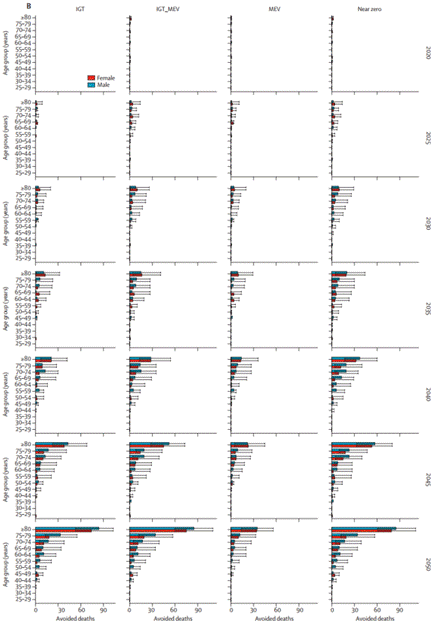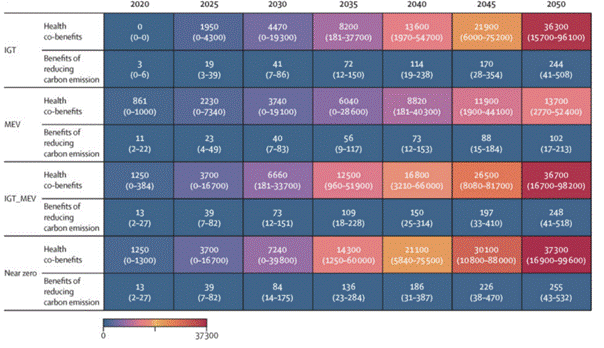Liu Zhu's Research Group of the Department of Earth System Science (DESS) Tsinghua University has recently conducted a research on Beijing residents' travel modes, and analyzed the health co-benefits of travel modes on people of different age groups and genders. Through the scenario analysis of climate mitigation strategies for residents' travel modes in the city proper of Beijing, it has been found that the combination of walking, cycling, public transport (referred to as green transport for short) and electric vehicle travel can promote the low-carbon sustainable development of the transportation sector, of which the increase of green transport plays a crucial role. From 2020 to 2050, under the four mitigation scenarios, men would have gained more health co-benefits and economy than women (Fig. 1). Because of the aging population and the high health risks of the elderly exposed to air pollution, people over 50 years old in Beijing benefit more from the traffic decarbonizing mitigation strategy (Fig. 1). The research results, titled "Scenarios of demographic distributional aspects of health co-benefits from decarbonizing urban transport", were published in the journal The Lancet Planetary Health on June 14th, 2022.
Taking the period from 2020 to 2050 as the time dimension, this paper sets four emission mitigation scenarios of residents' transportation: green transport (referring to active travel and public transport), low-carbon travel (referring to low-carbon motor vehicles, such as electric vehicles), green+low-carbon travel and near-zero emission (realizing 100% electrification of residents' transportation vehicles by 2050). This study applies an integrated assessment model that combines a grey forecasting model, a low-carbon traffic development model, the GAINS-ASIA model, a health assessment model (i.e. GEMM), and a health economic model.
The results show that of the four alternative mitigation scenarios, the near zero scenario achieves the largest health co-benefits and economic benefits, preventing 300 deaths at most (Fig. 1), with health co-benefits and CO2 cost-saving an equivalent of 0·01% (0·00–0·03%) of Beijing's gross domestic product in 2015 by 2050. (Fig. 2) By comparing four traffic emission mitigation scenarios, it has been found that, compared with a single traffic emission mitigation measure, the combination of active travel, public transport and electric vehicle travel can yield more health and economic synergy benefits.

Fig. 1 Avoided deaths (measured by sex and age) under four mitigation scenarios

Fig. 2 Total economic benefits of four mitigation scenarios (including monetary health co-benefits and economic benefits from reduced CO2 emissions. (Unit: USD 1,000)
Through a case study of Beijing residents' travel modes, this study shows the potential of urban traffic emission mitigation and health co-benefits. It is suggested that green transport should be prioritized in the future development of low-carbon transportation. At the same time, this study analyzed the health co-benefits for people of different ages and genders, conducive to providing a scientific basis for climate transformation.
The research was jointly completed by scientists from Tsinghua University in conjunction with several domestic and foreign research institutions. Dr. Lu Chenxi, co-trained by Tsinghua University and the University of Exeter, UK, is the first author, Associate Professor Liu Zhu and Dr. Lu Chenxi of the Department of Earth System Science in Tsinghua University are the corresponding authors, and Professor W. Neil Adger of the Department of Geography, the University of Exeter, UK, Professor Karyn Morrissey of the Sustainability Division, Department of Technology, Management and Economics, Technical University of Denmark, Lyngby, Denmark, Associate Professor Zhang Shaohui of Beihang University, and Visiting Associate Professor Sergey Venevseky of the Department of Earth System Science, Tsinghua University, are the co-authors of the thesis. This research is supported by the National Natural Science Foundation of China, among others.
Paper link:
Chenxi Lu*, W. Neil Adger, Karyn Morrissey, Shaohui Zhang, Sergey Venevsky, Hao Yin, Taochun Sun, Xuanren Song, Chao Wu, Biqing Zhu, Zhu Liu*. Scenarios of demographic distributional aspects of health co-benefits from decarbonizing urban transport. The Lancet Planetary Health, 2022, 6, e461-e474.
https://www.thelancet.com/journals/lanplh/article/PIIS2542-5196(22)00089-4/fulltext
Written by Lu Chenxi and Liu Zhu
Edited by Wang Jiayin
Reviewed by Zhang Qiang